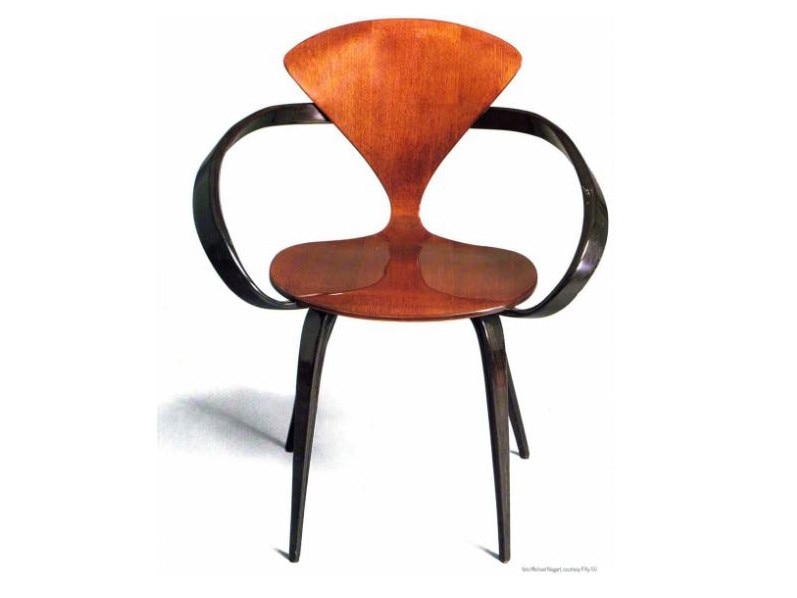Vico Magistretti, the Atollo or the Eclisse; George Nelson and Herman Miller, The Coconut Chair. Playing the game of “citing one among so many,” however, it would become difficult to cover the endless production of design icons associated with these two figures, and the most relevant name of American modernist furniture.
One story, however, brought them all together, the story of a chair conceived in the 1950s and then realized in the 1980s, amid material experimentation and aesthetic analogies perfectly suited to both eras. This story was told to Domus by Nelson and Magistretti themselves in march 1986, published on issue 670.
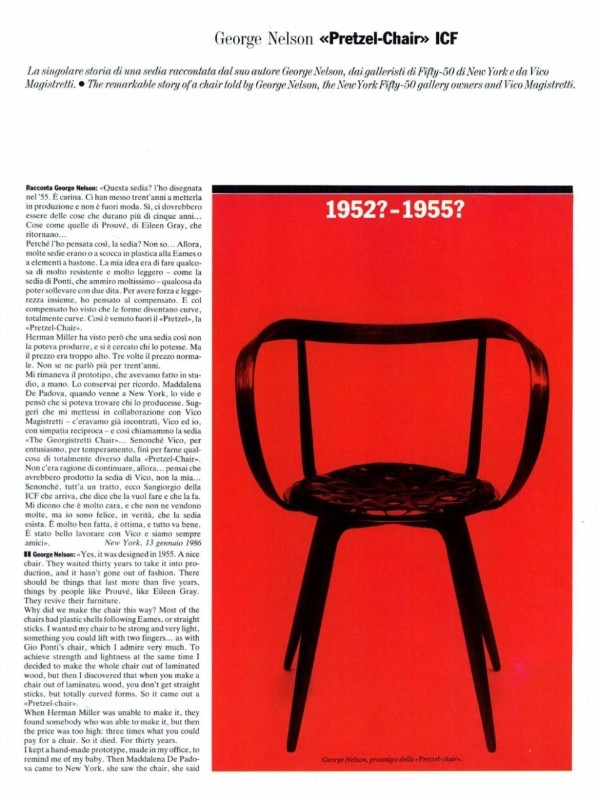
George Nelson “Pretzel-Chair” Icf
George Nelson:
“Yes, it was designed in 1955. A nice chair. They waited thirty years to take it into production, and it hasn’t gone out of fashion. There should be things that last more than five years, things by people like Prouvé, like Eileen Gray. They revive their furniture.
Why did we make the chair this way? Most of the chairs had plastic shells following Eames, or straight sticks. I wanted my chair to be strong and very light, something you could lift with two fingers... as with Gio Ponti’s chair, which I admire very much. To achieve strength and lightness at the same time I decided to make the whole chair out of laminated wood, but then I discovered that when you make a chair out of laminated wood, you don’t get straight sticks, but totally curved forms. So it came out a “Pretzel-chair”.
When Herman Miller was unable to make it, they found somebody who was able to make it, but then the price was too high: three times what you could pay for a chair. So it died. For thirty years.
I kept a hand-made prototype, made in my office, to remind me of my baby. Then Maddalena De Padova came to New York, she saw the chair, she said ‘we can find somebody to make it’. And suggested that I made a collaboration with Vico Magistretti. Vico and I had just met and liked each other very much, so we called it the Georgistretti Chair. Then Vico, according to his temperament... his was such an enthusiasm... made a different chair, completely different from the Pretzel-Chair... so there was no point to continue. I thought they would do Vico’s chair and not mine, and... Then suddenly Sangiorgio of ICF came by, and said he would like to make it in Milan, and now he makes it, and I am told it is very expensive... and they don’t sell very many of it, but I am very happy that the chair exists. It’s very well built, and everything was pleasant. Working with Vico was fun, and we are still friends”.
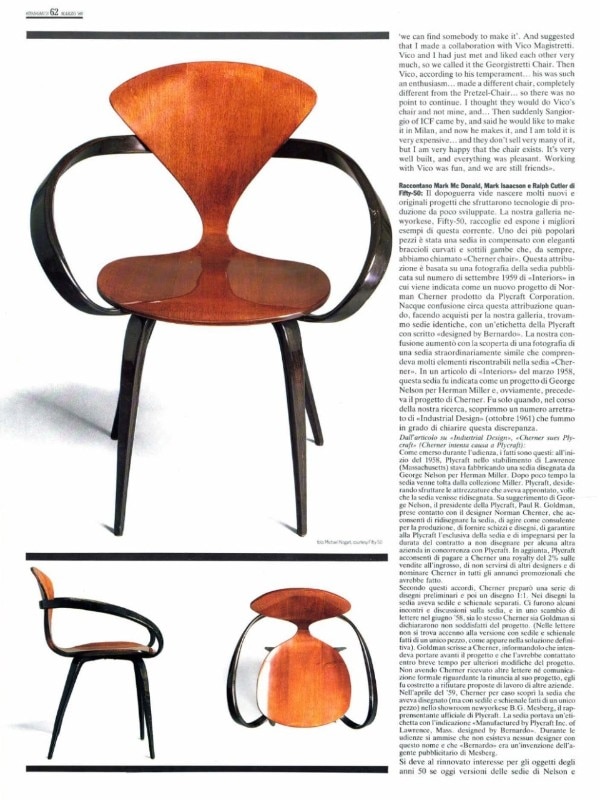
Vico Magistretti
MR: In the affaire of “Pretzel” the role played by industry, indeed by one industrial company - Herman Miller - seems paramount. The company’s design sector was directed by George Nelson from 1944 to 1965. Concernmgthe Herman Miller philosophy, Nelson pronounced the celebrated words: “It’s a small company in a small town. Distinguished by the following principles:... Design is an essential component of our activity... It is you who decide what you want to produce... There is a market for every good design...”. VM: George’s crucial contribution is still probably the creation of one of the most exciting phenomena of union between design and production: the Miller phenomenon. He was even capable at times of retiring into the background, almost as if he had decided that his own creative longa manus should be Charles Eames. In point of fact, behind every detail of the whole operation was his personal action designed to establish a “cultural” structure which could challenge time through sharply differentiated products, but which would present themselves to the world compactly and achieve a great commercial hit. His was an absolutely unusual pratice, untypical of the American scene, because it was founded upon a deep cultural substratum. George is a man who could talk quietly about himself. He created objects charged with intelligence and humour. The humour was substantially bitter, typical of a sad character who was ironic about himself and about design.
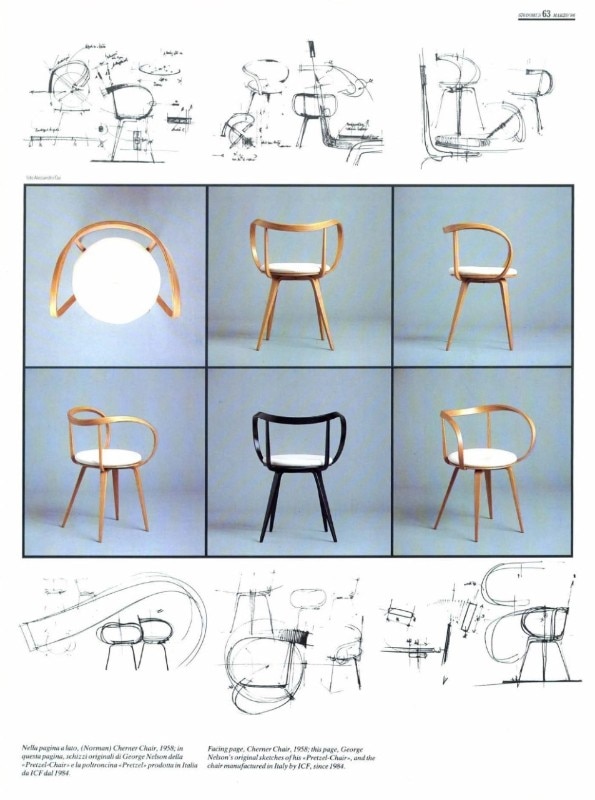
MR: In his book of 1935 “Chairs”, Nelson maintains that every cultural system focuses its efforts upon one particular symbolic item. In the western world which emerged from Worlds War II, that item became the chair. VM: Let’s contextualize this comment on Pretzel. Basically, it takes up the language of bent plywood, the fundamental expressive system of all Eames’s output. He does not however adopt it as a “technological” statement, but as a sign, a sign which is a declaration: technique makes it possible to bend the wood as desired.
MR: Nelson writes a propos the 1940s generation of architects and designers: “In the raging battle between conservatorism and modernism, the battalions in the front lines of progress had to have their banners - the symbols included monk-cloth, Mirò reproductions, Aalto chairs and Calder mobiles”. Perhaps in Pretzel the reference to a Scandinavian atmosphere is stronger than the affinity with contemporary American bent plywood products. VM: The things by Aalto are first of all a record of the correct use of bent plywood. The use which Nelson makes of it is practically the opposite. He was not concerned about making a manufacturable object He created an image by using a material that allowed him to execute a sculpture. Furthermore, in Aalto's work the bond between function-technology and nationality is indisputably much stronger. One understands in fact only now how form is dictated not solely by technological and functional input, but by environmental values. Design is in fact the fruit of a memory. We must however be careful not to interpret this concept reductively. National design does not mean folklorish design. MR: In the attempt to determine certain archetypal references to Pretzel, we must mention Michael Thonet's bent beech wood products. VM: Work in the house, in the landscape and in the domestic universe must undoubtedly be different, but different in that it is necessary “to see less”, to decrease the signs. So the reference to the Thonet chair is an apt one. It is an object which, in one way, “one does not see”, and in another way becomes emblematic, qualifying the place in which it is situated, thanks to its colloquial, unifying tone. This is a long way from what today seems to attract the attention of the media, which impose the stereotype of originality and the denial of repetitiveness. Whereas, repetitiveness is one of the greatest conquests of our culture.
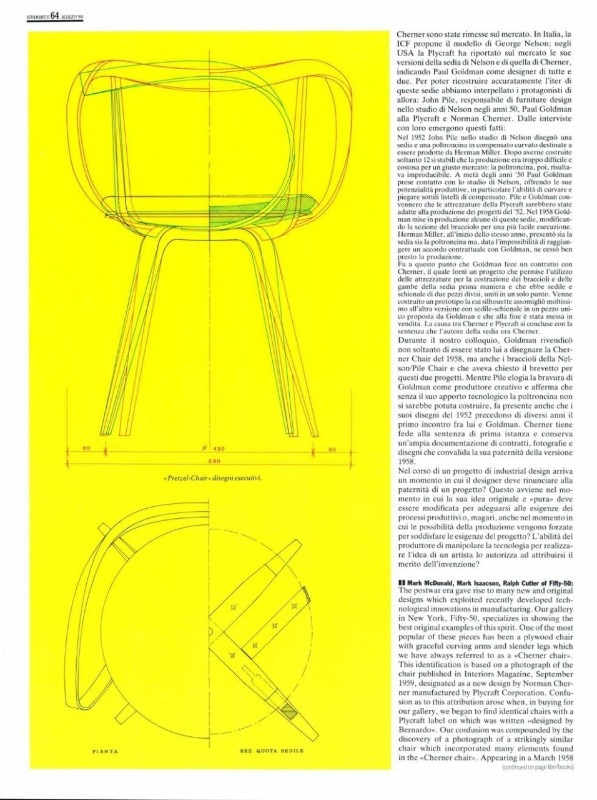
MR: In the America of the '50s a complex and exciting relationship grew up between two leading enterprises: Herman Miller and Knoll. The first embarked upon a path of experimental research, the second started to reproduce the “great masters”, beginning straight away with furniture conceived in 1920 by Mies van der Rohe. Must we fit Pretzel into this repro outlook, which has continued since then without interruption? VM: Knoll is academy. Miller a firm. It’s quite different. This Pretzel is a repro born by chance, without any desire for celebration. George himself had forgotten this chair... MR: In 1952 Nelson said: “Now the battle is over... Even department stores sell modern furniture... But this also means that we have something that has been generally accepted as a style..., a word which less than a decade back... was anathema because it was the “styles” which were being fought. Only now... we find that we are saddled with exactly what we thought we were fighting... (a) style...”. VM: That’s why George is a great master. As soon as he senses that he has won a battle, he says he has lost it.


